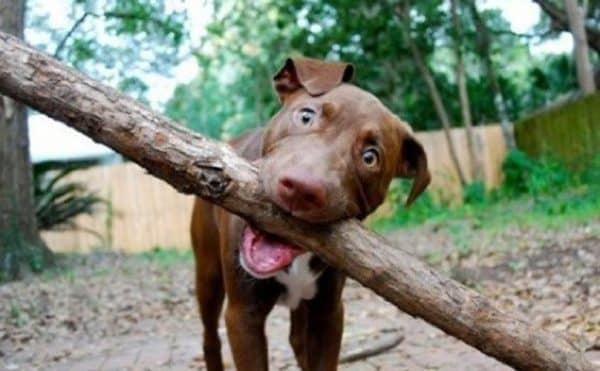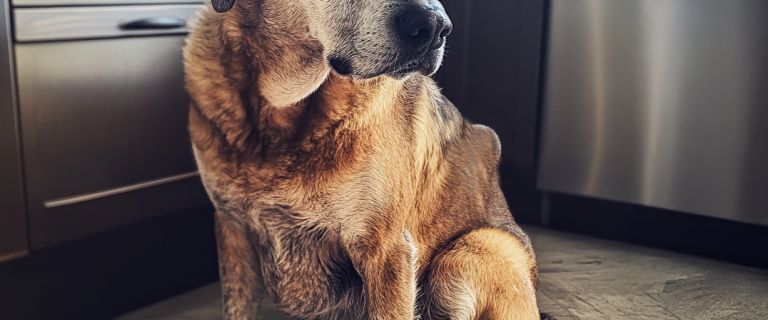
Why do dogs like sticks? I and my fellow dog owners have often Googled this looking for an answer. Dogs seem to be obsessed with sticks. Big sticks. Little sticks. It doesn’t seem to matter what size or shape a stick might be, if your dog sees it, chances are he’s going to want to grab it. If you have a backyard with trees, you might have noticed that your dog will actually find and gather sticks. It seems like it’s a dog’s mission to get every stick he sees. So why do dogs like sticks? Today, we’re going to be discussing that very question.
Why Do Dogs Like Sticks
There are a few reasons that dogs seem to prefer sticks above any other object. Whether it’s a bully stick that you’ve bought for your dog or a stick he found in the yard, chances are your dog gets extremely excited about any sort of stick. But why? The answer lies in his DNA.
All dogs are descended from wolves. Over centuries, humans have used selective breeding to create a massive variety of breeds from what began as wolf companions thousands of years ago. While modern dog breeds may be far removed from what they originally were when man and canine first created that fateful bond, much of their instincts still remain intact.
Instinct
The predominant theory among animal researchers is that dogs love to gather and chew sticks because they resemble bones. In the wild, wolves eat almost every part of their prey, including the bones. Wolves will crack open bones to get to the nutrient-rich marrow which is a valuable source of calcium. Dogs are attracted to gathering and chewing sticks because of this bone-chewing instinct from their wolf cousins.
Pleasure
Dogs are very smart, and they know that a stick is just a stick. However, the bone-chewing instinct is still satisfied by gathering and chewing sticks. Closely related to this instinct to chew is the joy that dogs get from it. Chewing sticks of any kind, from twigs and branches to bully sticks and other chew toys, has been shown to release endorphins in dogs. These endorphins are the “happy” chemical. So the other reason dogs love to chew is that it’s just plain fun.
Is It Safe for Dogs to Chew Sticks
From what we just talked about, chewing on sticks may seem like a safe, natural way for dogs to have a little fun. After all, throwing a stick for our dogs is one of the most classic scenes in all of dog ownership. When we think of playing with our dogs, we think of throwing sticks. However, the wholesome image could not be further from the truth. It is downright dangerous for dogs to eat sticks.
Chewing sticks and wood can cause severe injury to dogs. Wood splinters very easily when chewed, especially when chewed by an overzealous pooch. These splinters can lodge in the dog’s mouth in places like his upper palette and between the gum and tooth causing injury and infection. More seriously, ingested wood splinters can lead to perforations in a dog’s intestine, and large pieces of swallowed wood can cause intestinal blockage. Both of these can be deadly and require surgery to fix.
Is It Safe for Dogs to Chew Bones
So if dogs chew on sticks because they have an instinctive drive to chew bones, can you simply give your dog a bone? Eh, that falls into a grey area. You can give your dog bones if you give him the right ones, but I wouldn’t do it. Certain bones are relatively safe for your dog. I emphasize the word “relatively”.
I used to have a Rat Terrier named Buster. He was an avid chewer – I mean constant. He blew through chew toys like you wouldn’t believe, so we had the bright idea of getting him a knuckle bone to chew on. A knuckle bone is basically the head of a cow’s femur. Buster loved it. He couldn’t get enough of that thing, and he chewed it vigorously. He chewed it too vigorously, actually. Before we knew it, he had broken off four molars. We had to have them removed because he broke them off right down to the gumline and still kept chewing. So, needless to say, I wouldn’t give them to my dog. However, if your dog isn’t quite so aggressive, the proper bone can be safe.
Don’ts for Bones
Don’t:
- Give your dog cooked bones. They can splinter, causing mouth and intestinal injuries.
- Give your dog chunks of bone that can be swallowed. They can cause intestinal blockage.
- Let your dog chew or crack the bone into small pieces.
Do:
- Give your dog raw bones. They won’t splinter the way cooked bones will.
- Take the bone away after 10 to 15 minutes.
- Give large and giant breed dogs large bones so they can’t swallow them whole.
Is it Safe for Dogs to Chew Rawhides
So we’ve answered: why do dogs like sticks. We’ve also seen that bones can be safe but not necessarily ideal. But, what about rawhides? After all, they’re a natural way for a dog to get his chewing fix in. Rawhides are fairly safe. I would opt for rawhides over actual bones, but you still need to be careful.
In general, rawhides are safe for dogs that are soft chewers. Small breeds, puppies, and elderly dogs all fall into this category. Small breed dogs simply don’t have the bite power to tear through a rawhide, and puppies and elderly dogs tend to have more tender mouths, making them less likely to want to chew hard enough to rip a rawhide into pieces that they can then swallow.
The danger of rawhides is really most associated with aggressive chewers. Breeds with powerful jaws like Rottweilers and Pit Bulls immediately come to mind. They have the power in their jaws to easily destroy a rawhide in minutes, ripping it apart into chunks which they can then swallow. In addition, rawhides can be dangerous for giant breed dogs if they aren’t the proper size.
That being said, rawhides tend to be generally safe if given responsibly. Always give your dog a rawhide of appropriate size. Ensure that it’s large enough to prevent it being swallowed whole and to give your dog plenty of chewing action without being destroyed and swallowed in a blink. Obviously, the larger the dog, the larger the rawhide should be. Finally, opt for rawhides that are braided. These chews feature a few pieces braided together, making them more fun to chew on and harder to destroy.
Is it Safe for Dogs to Chew Bully Sticks
Yes! In fact, bully sticks are just about the best chew option for dogs. Bully sticks are an all-natural, single-ingredient, easily-digestible chew made from beef muscle. They don’t splinter or crack teeth like bone, and because they’re easily-digestible, there are no risks of intestinal blockage.
They’re also quite healthy. They’re filled with protein and have no additives or preservatives. They’re full of amino acids, as well, which supports brain, body, and coat health. Finally, these sticks help reduce plaque buildup. As your dog chews through the tough treat, the plaque is scraped away from his teeth before it gets a chance to build up. These sticks come in a variety of sizes, as well, making them an excellent option for all dogs from toy breeds to massive giant breed behemoths.
Why Do Dogs Like Sticks? Because Chewing is Fun!
Why do dogs like sticks? Because it’s fun and it’s instinct, and those two things tend to go hand in hand for dogs. Your dog will always be attracted to sticks. He’ll always want to hoard them and chew on them, but as cute as it is, don’t let him do it. Chewing sticks is dangerous and can lead to serious health issues. Instead, ensure that your dog always has a bully stick available to help him satisfy his need to chew.
Although many owners swear by bones and rawhides, I prefer to stay away from them. As a former Vet Assistant, I can say from experience that low risk does not equal no risk. It’s far better to give your dog a bully stick that he can chew to his heart’s content than a bone that might crack his teeth or a rawhide that he might swallow whole. I’ve experienced the first and assisted with a surgery for the latter. It’s not fun.
So now that you know why your dog loves sticks, satisfy that urge with something that is good for him and helps him have all the chewing fun he wants.
Author
-

A former Veterinary Assistant at Southwest Animal Care Hospital, Ben is an animal lover, blogger, and all-around geek. Along with writing for DogVills, Ben runs his own virtual assistant company, BizzyBim.
View all posts


